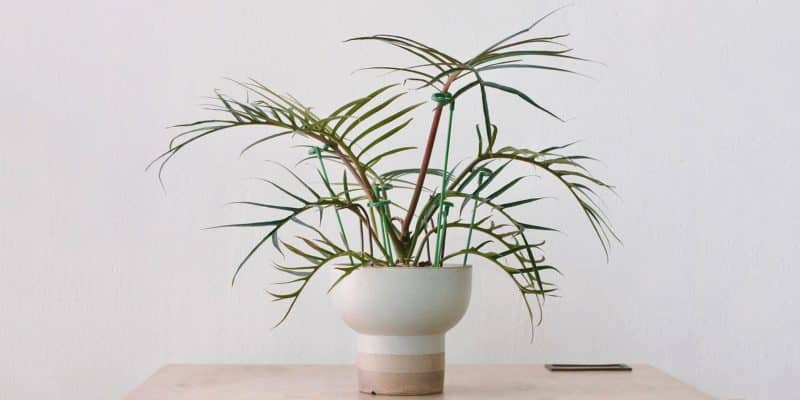Philodendron tortum is an eye-catching houseplant that’s perfect for adding a unique and tropical twist to your home. Its intriguing, spiky leaves seem to dance in a graceful ballet, each one telling its own story. And guess what? It’s easier to care for than you might think!
In this article, we’ll introduce you to this standout plant and share some essential tips about how to care for Philodendron tortum. Whether you’re a seasoned green thumb or new to the world of houseplants, this is one you’ll definitely want to add to your collection.
Table of Contents
Philodendron Tortum Plant Care Guide
History, Habitat, and Characteristics

Philodendron tortum, native to Brazil’s lush rainforests, boasts vibrant twisted leaves that create a whimsical and enchanting display. As the leaves unfurl, each one exhibits its own unique curls and twists, akin to a botanical ballet performance, finally ending with palm-like, spiky foliage.
This extraordinary houseplant stands out from the rest of its Philodendron brethren due to its slender stems and elongated, narrow leaves. Its status as an epiphytic species further adds to its distinctiveness, even within the arum family.
Philodendron tortum grows aerial roots that extend from the main stem and latch onto trees or other supports. This allows the plant to grow vertically while absorbing nutrients and moisture from its surroundings.
Care-wise, the Philodendron tortum is a bit of a diva, but well worth the effort. To encourage its natural growth habit and prevent it from flopping over as it grows, consider offering support in the form of a moss pole or similar structure.
Ready to give this twisty plant a whirl?
Light
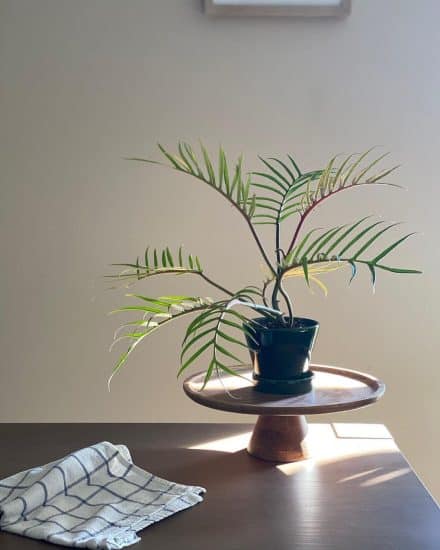
Native to Brazil’s Amazonian rainforests, the Philodendron tortum plant thrives if you can mimic a tropical climate with bright, indirect sunlight. Since it’s a fast-growing plant with minimal leaf surface, finding the ideal Philodendron tortum light spot in your home might take some ingenuity — think mirrors, grow lights, or other light-enhancing methods.
Too much direct sunlight or direct afternoon sun can cause the leaves to become discolored, faded, or scorched, often resulting in brown or yellow leaves. If you spot these signs, it’s time to move your plant away from direct light or use a sheer curtain to filter the sun’s intensity.
On the other hand, insufficient light leads to slow, leggy growth as the plant reaches for the bright light it craves. In this scenario, consider adjusting your plant’s location or using artificial light sources for a happier, healthier Philodendron tortum.
Water
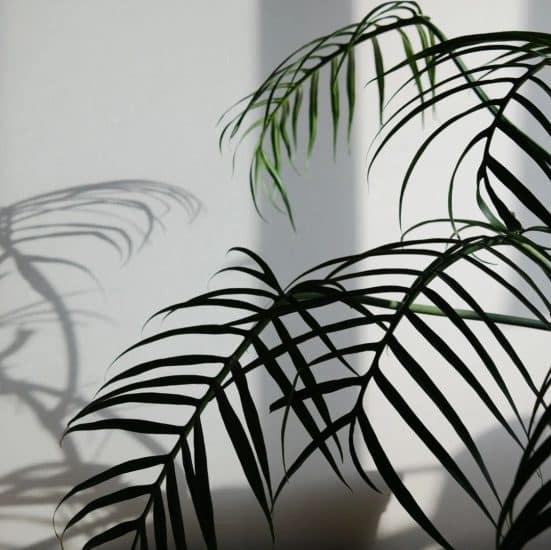
Tropical plants like philodendrons enjoy consistently moist soil that’s never either completely dry or completely wet. Sound like a trap? Don’t worry, it’s easier than you think.
The trick to watering Philodendron tortum is to let the top inch of soil dry out before you water again. This indicates that the plant has taken up the available water and is ready for more.
If your plant is getting insufficient water, you may notice significant drooping, hard soil, and sad leaves. Make sure you don’t let the soil completely dry out. Use your finger to test that only the top inch of soil has dried out and then water again.
You want to avoid overwatering, though, because it’s the most common way to kill a plant. We all love our plants and want to give them attention, so if you can’t resist the pull to water your Philodendron tortum, try misting it weekly instead of overwatering it.
Temperature and Humidity
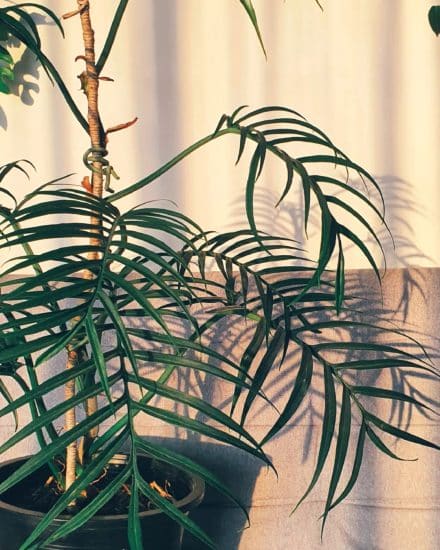
Growing Philodendron tortum successfully means paying attention to both temperature and humidity. Let’s explore the ideal conditions and the signs of getting too much or too little of each.
When it comes to temperature, Philodendron tortum enjoys warm surroundings similar to its tropical rainforest origins. Aim for room temperatures between 65°F and 80°F. Exposure to cold temperatures below 65°F may cause stress, leading to wilting or yellowing plant leaves. If it gets too hot, you may see leaves that curl or droop.
Keep your Philodendron tortum away from cold drafts, which can harm or even kill your plant. During winter, avoid placing it near windows, vents, or doors that let in cold air. Watch out for air conditioning units during summer as well, because cold air can cause leaves to curl, turn brown or yellow, or drop.
As for humidity, the Philodendron tortum prefers higher moisture levels in the air. The ideal humidity will be around 50%-70%. This plant’s resilience in average humidity hasn’t been fully tested, but it has thrived in both indoor and outdoor environments with high humidity.
If you’re not getting the humidity right, your plant will tell you — you just need to know the signs. Curling or drooping leaves with brown, crispy tips indicate low humidity, while yellow or mushy leaves and stems suggest excessive humidity. Keep an eye out for mold or mildew as well, especially in the folds of its deeply lobed leaves, where moisture may accumulate.
To raise humidity:
- Use a humidifier for a few hours each day to boost moisture levels in the air near your plant.
- Set up a pebble tray by putting a layer of pebbles and water in a tray beneath your plant. The evaporating water increases humidity around the plant.
- Group your Philodendron tortum with other humidity-loving plants so they can share moisture through a process called transpiration.
- If your bathroom gets bright but indirect light, consider putting your plant there, since humidity levels are usually higher due to showers and baths.
Soil and Planting
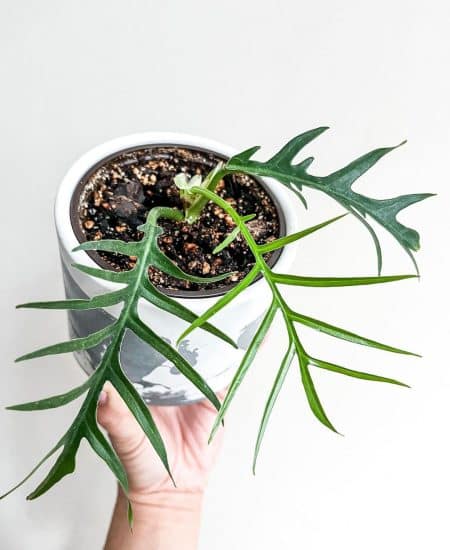
To create the right potting mix for your Philodendron tortum, you need a soil combination best for aroid plants. Let’s get into how to make that.
Coco coir, orchid bark, and fir bark all help create a light and airy mix, allowing the roots to breathe but aiding in moisture retention.
Pumice or perlite will improve drainage, providing the perfect balance for healthy root growth.
Incorporating elements such as charcoal, myco, and Osmocote can help support healthy root development and provide essential nutrients.
Philodendron tortum likes a neutral soil, so avoid adding too much of anything that will increase the acidity or alkalinity of your mix. Start with regular potting soil for about 50% of your mix, and add the rest in equal amounts.
If you don’t have access to all that many indoor plant soil ingredients, just adding perlite will do a lot.
Repotting your Philodendron tortum is essential when its roots have become overcrowded or if the soil mix has broken down, which usually happens every 2-3 years. Choose a new pot only slightly larger than the current one — with a drainage hole — to promote healthy root growth and avoid excessive moisture.
Fertilizing
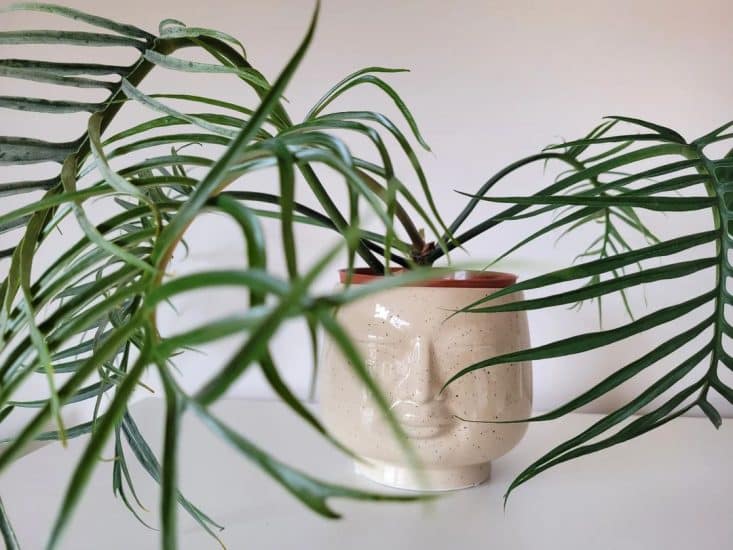
When fertilizing your Philodendron tortum, a liquid houseplant fertilizer applied during watering will help your plant keep up with its fast-growing habit. Be sure to only fertilize during the growing season, since plant growth slows during the winter.
Over-fertilizing can cause yellowing leaves, poor growth, and root burn, so you may want to dilute your fertilizer to a fraction of the recommended amount to start with, then gradually increase. If you notice signs of too much fertilizer, reduce the frequency and strength of the fertilization, and flush the soil with water to remove excess nutrients from the soil.
Propagation
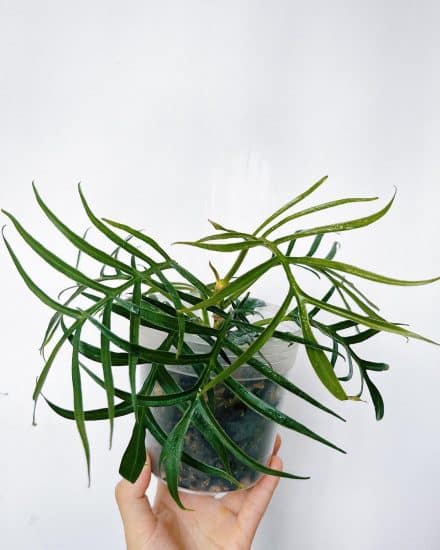
Propagating Philodendron tortum allows you to share this beautiful plant with friends or grow your own indoor jungle. In this guide, we’ll show you how to propagate Philodendron tortum using stem cuttings.
This method works well with water, perlite, or coconut coir (an eco-friendly alternative to sphagnum moss), so feel free to choose the one that best suits you.
Propagating Philodendron tortum via stem cuttings in water:
- Let the last leaf harden before you start. It’s essential to make sure your cutting is strong and robust enough to begin the propagation journey.
- Clean your plant with natural soap and water to remove any pests or dirt. This will help you start with a clean, healthy cutting that’s ready to grow in its new environment.
- Snip a healthy stem from your Philodendron tortum using sterilized pruning shears or scissors. Choose a stem with at least 2-3 leaves and a healthy node to increase your chances of successful rooting.
- Strip away leaves from the bottom nodes of your cutting. This leaves room for the roots to grow and prevents leaves from decaying in the water.
- Pop the cutting in a container of room-temperature water and find a spot with bright indirect sunlight, such as morning sunlight. If you want to boost humidity, just cover your cutting with a clear plastic bag or a cut-open soda bottle.
- Refresh the water every 2-3 days to keep your cutting’s environment clean and encourage healthy root development.
- Watch for root growth! Once you see white roots that are about 2 inches long, it means your cutting is ready to be potted in well-draining potting soil.
Our propagation tips:
- For an alternative to stem cuttings, you can try air layering your Philodendron tortum with sphagnum moss. This process grows new roots before you make a cutting.
- The best time to propagate your Philodendron tortum is during the growing season — early spring or summer.
- Keep humidity and indirect light levels high throughout the propagation process.
Common Issues
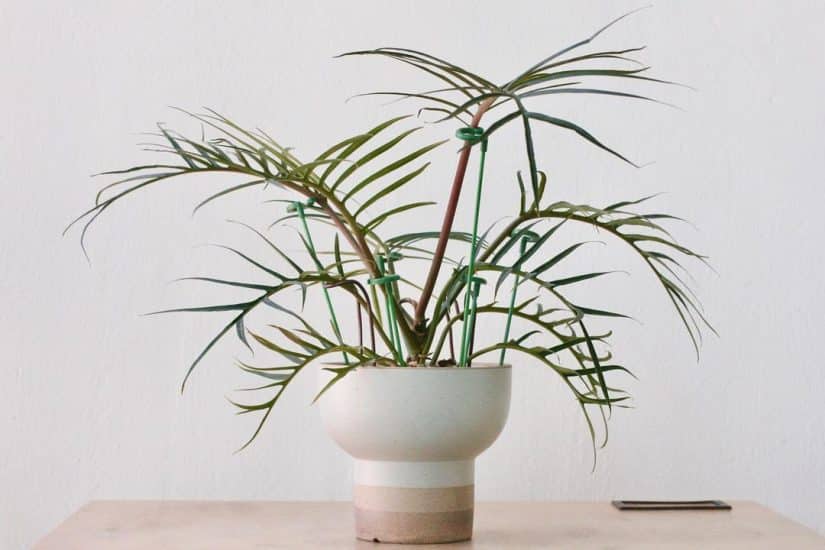
Leaf Loss
Leaf loss in Philodendron tortum can be disappointing, and it’s often the result of overwatering. When you notice leaves dropping, take a moment to evaluate your plant’s watering habits and soil moisture.
It’s important to strike the right balance. Letting the soil dry out a bit between waterings prevents excess water and potential damage to the plant. Check for proper drainage holes in your pot, as waterlogged soil can also lead to leaf loss.
If you’re still having issues, consider repotting the plant in fresh soil that offers better drainage, perhaps adding perlite or another well-draining amendment to the soil mix, and adjust your watering routine as needed.
Slow Growth
When your Philodendron tortum experiences slow or stunted growth, it’s time to investigate the possible culprits: inadequate lighting and insufficient nutrients.
Start by assessing the lighting conditions — your plant should enjoy bright, indirect sunlight. If it’s tucked away in a dark corner or too far from a light source, try moving it to a better-lit area or using a grow light to supplement its needs.
Next, examine whether you’re providing the right nutrients during the growing season (early spring and summer). A balanced liquid fertilizer applied every 4 to 6 weeks should do the trick.
If the soil is old and depleted, or if your plant’s roots have outgrown the pot, repotting your plant in a fresh, nutrient-rich potting mix, and perhaps a slightly larger pot, can make a world of difference.
Pests and Diseases
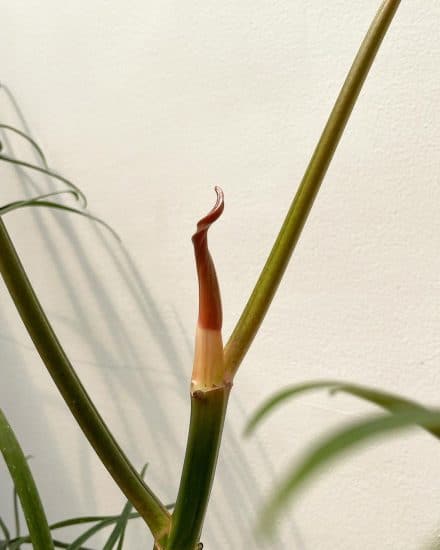
It’s true, your Philodendron tortum is usually a strong and hardy houseplant, but it might still encounter some pesky pests or diseases.
Pests
Though Philodendron tortum isn’t especially prone to pest issues, it’s wise to stay on your toes. Keep an eye out for spider mites, thrips, mealybugs, and scale, all common pests that can bother your plant. Make a habit of inspecting the leaves and stems for signs like tiny webbing, small white or yellow bugs, or cottony-looking growths.
Did you find an infestation? First, isolate your plant from other healthy plants.
Next, use a damp cloth to gently wipe off any affected areas. If the infestation is quite serious, mix water and a few drops of dish soap or use a ready-to-use insecticidal soap, such as neem oil.
Be sure to spray the plant thoroughly, covering both sides of the leaves. Repeat this treatment weekly until you’ve said goodbye to those pests for good.
If you noticed spider mites, you can do a lot to keep them away (while encouraging your plant’s growth) by keeping it in a humid, moist environment. Spider mites really hate moisture, so give those leaves a quick wipe-down with water every other week or so.
Root Rot
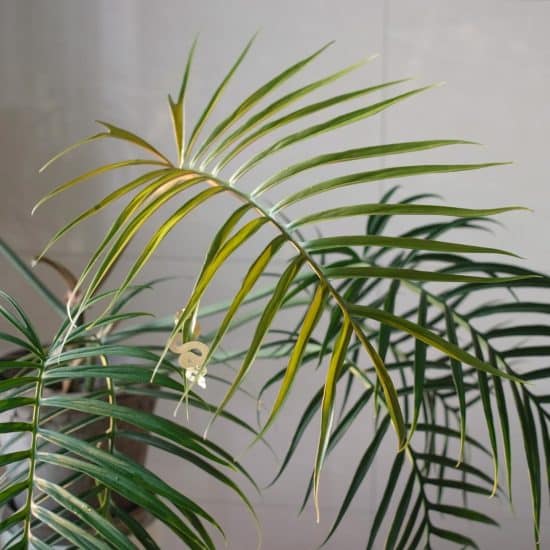
Rot can be a common issue for Philodendron tortum, often caused by overwatering, poorly draining soil, or a pot that lacks proper drainage. Watch for yellowing leaves, wilting, or a funky smell coming from the soil. Gently remove your plant from its pot and examine the roots. If they’re mushy, slimy, and dark in color, you’ve got the rot.
Don’t fret! Trim away those sickly roots with sterilized scissors. Repot your plant in fresh, well-draining soil, and double-check that the pot has enough drainage to avoid a repeat problem. In the future, wait for the soil to become dry at the top before watering your Philodendron tortum.
Sometimes, the rot is just too severe to save the whole plant. In this case, consider propagating cuttings from the healthy parts of your plant. This way, you’ll have a fresh start with a new, healthy Philodendron tortum.
Remember, using well-draining potting soil, ensuring sufficient light, and maintaining a moist soil environment can help it grow into a mature Philodendron tortum that’s more resistant to pests and diseases.
Conclusion
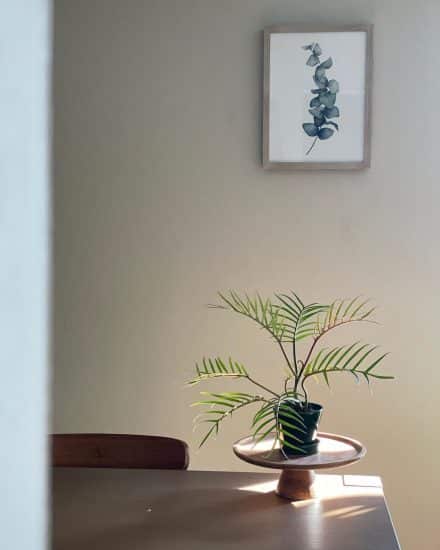
That wraps up our Philodendron tortum care guide! With its spiny leaves and enchanting appearance, this houseplant truly adds a unique (and twisty) flair to any indoor space. By following our care tips and addressing any challenges that may arise, you’ll be able to keep your Philodendron tortum healthy and thriving for years to come.
Philodendron tortum care summary:
- Provide bright, indirect light and avoid extreme sunlight conditions to prevent leaf discoloration or scorching.
- Maintain temperatures between 65-80°F and ensure a humidity range of 50%-70% for optimal growth.
- Use a well-draining potting mix and a pot with drainage holes.
- Fertilize with a balanced houseplant fertilizer during the growing season and monitor for any signs of over-fertilization.
We hope our guide has provided you with valuable insights and inspiration to successfully care for your Philodendron tortum. If you have any questions or want to share your experiences, feel free to reach out to us!
Happy growing, and enjoy the charm of your twisty wonder!
FAQ
What is the difference between Philodendron polypodioides and tortum?
These two plants are quite similar in appearance at first glance, but their leaves and growth patterns are slightly different. Tortum is smaller and more compact than polypodioides, which has thinner and flatter leaves. While they come from different parts of South America, their care guidelines are largely the same.
Is Philodendron tortum a climber or crawler?
Philodendron tortum is primarily a climber, meaning it grows upwards with the help of aerial roots that attach to nearby supports. In its natural habitat, this plant would climb up trees for support and to reach more sunlight.
When grown indoors, tortum will benefit from a sturdy support structure such as a moss pole or trellis. This support will not only help the plant maintain an upright growth habit, but also allow its stunning leaves to showcase their full potential.
Is Philodendron tortum a fast grower?
While the growth rate of Philodendron tortum may not be as rapid as some other Philodendron species, it’s still considered a moderately fast grower under the right conditions.
To encourage optimal growth, ensure your tortum receives bright indirect light and is kept in a warm, humid environment. Proper watering and regular fertilizing during the spring and summer will also contribute to a healthy and steadily growing plant.

